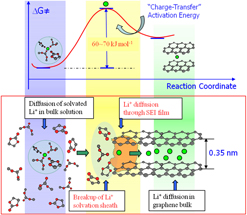Crossref Citations
This article has been cited by the following publications. This list is generated based on data provided by
Crossref.
von Wald Cresce, Arthur
Borodin, Oleg
and
Xu, Kang
2012.
Correlating Li+ Solvation Sheath Structure with Interphasial Chemistry on Graphite.
The Journal of Physical Chemistry C,
Vol. 116,
Issue. 50,
p.
26111.
Li, JunTao
Su, Hang
Huang, Ling
and
Sun, ShiGang
2013.
Investigation of interfacial processes in graphite thin film anodes of lithium-ion batteries by both in situ and ex situ infrared spectroscopy.
Science China Chemistry,
Vol. 56,
Issue. 7,
p.
992.
Sirisaksoontorn, Weekit
and
Lerner, Michael M.
2013.
The Electrochemical Synthesis of the Graphite Intercalation Compounds Containing Tetra-n-alkylammonium Cations.
ECS Journal of Solid State Science and Technology,
Vol. 2,
Issue. 9,
p.
M28.
Llanio-Trujillo, J.L.
Marques, J.M.C.
and
Pereira, F.B.
2013.
New insights on lithium-cation microsolvation by solvents forming hydrogen-bonds: Water versus methanol.
Computational and Theoretical Chemistry,
Vol. 1021,
Issue. ,
p.
124.
Bogle, Xavier
Vazquez, Rafael
Greenbaum, Steven
Cresce, Arthur von Wald
and
Xu, Kang
2013.
Understanding Li+–Solvent Interaction in Nonaqueous Carbonate Electrolytes with 17O NMR.
The Journal of Physical Chemistry Letters,
Vol. 4,
Issue. 10,
p.
1664.
Shkrob, Ilya A.
Zhu, Ye
Marin, Timothy W.
and
Abraham, Daniel
2013.
Reduction of Carbonate Electrolytes and the Formation of Solid-Electrolyte Interface (SEI) in Lithium-Ion Batteries. 1. Spectroscopic Observations of Radical Intermediates Generated in One-Electron Reduction of Carbonates.
The Journal of Physical Chemistry C,
Vol. 117,
Issue. 38,
p.
19255.
Manzhos, Sergei
and
Giorgi, Giacomo
2013.
Bridging the Fields of Solar Cell and Battery Research to Develop High-Performance Anodes for Photoelectrochemical Cells and Metal Ion Batteries.
Challenges,
Vol. 4,
Issue. 1,
p.
116.
Xu, Kang
2014.
Electrolytes and Interphases in Li-Ion Batteries and Beyond.
Chemical Reviews,
Vol. 114,
Issue. 23,
p.
11503.
Mehrotra, Amal
Ross, Philip N.
and
Srinivasan, Venkat
2014.
Quantifying Polarization Losses in an Organic Liquid Electrolyte/Single Ion Conductor Interface.
Journal of The Electrochemical Society,
Vol. 161,
Issue. 10,
p.
A1681.
McOwen, Dennis W.
Seo, Daniel M.
Borodin, Oleg
Vatamanu, Jenel
Boyle, Paul D.
and
Henderson, Wesley A.
2014.
Concentrated electrolytes: decrypting electrolyte properties and reassessing Al corrosion mechanisms.
Energy Environ. Sci.,
Vol. 7,
Issue. 1,
p.
416.
Smith, Jacob W.
Lam, Royce K.
Sheardy, Alex T.
Shih, Orion
Rizzuto, Anthony M.
Borodin, Oleg
Harris, Stephen J.
Prendergast, David
and
Saykally, Richard J.
2014.
X-Ray absorption spectroscopy of LiBF4 in propylene carbonate: a model lithium ion battery electrolyte.
Phys. Chem. Chem. Phys.,
Vol. 16,
Issue. 43,
p.
23568.
Lapidus, Saul H.
Rajput, Nav Nidhi
Qu, Xiaohui
Chapman, Karena W.
Persson, Kristin A.
and
Chupas, Peter J.
2014.
Solvation structure and energetics of electrolytes for multivalent energy storage.
Phys. Chem. Chem. Phys.,
Vol. 16,
Issue. 40,
p.
21941.
Xiang, Hongfa
Mei, Donghai
Yan, Pengfei
Bhattacharya, Priyanka
Burton, Sarah D.
von Wald Cresce, Arthur
Cao, Ruiguo
Engelhard, Mark H.
Bowden, Mark E.
Zhu, Zihua
Polzin, Bryant J.
Wang, Chong-Min
Xu, Kang
Zhang, Ji-Guang
and
Xu, Wu
2015.
The Role of Cesium Cation in Controlling Interphasial Chemistry on Graphite Anode in Propylene Carbonate-Rich Electrolytes.
ACS Applied Materials & Interfaces,
Vol. 7,
Issue. 37,
p.
20687.
von Wald Cresce, Arthur
Gobet, Mallory
Borodin, Oleg
Peng, Jing
Russell, Selena M.
Wikner, Emily
Fu, Adele
Hu, Libo
Lee, Hung-Sui
Zhang, Zhengcheng
Yang, Xiao-Qing
Greenbaum, Steven
Amine, Khalil
and
Xu, Kang
2015.
Anion Solvation in Carbonate-Based Electrolytes.
The Journal of Physical Chemistry C,
Vol. 119,
Issue. 49,
p.
27255.
Barnes, Taylor A.
Kaminski, Jakub W.
Borodin, Oleg
and
Miller, Thomas F.
2015.
Ab Initio Characterization of the Electrochemical Stability and Solvation Properties of Condensed-Phase Ethylene Carbonate and Dimethyl Carbonate Mixtures.
The Journal of Physical Chemistry C,
Vol. 119,
Issue. 8,
p.
3865.
Husch, Tamara
Yilmazer, Nusret Duygu
Balducci, Andrea
and
Korth, Martin
2015.
Large-scale virtual high-throughput screening for the identification of new battery electrolyte solvents: computing infrastructure and collective properties.
Physical Chemistry Chemical Physics,
Vol. 17,
Issue. 5,
p.
3394.
Liu, Xing-Rui
Wang, Lin
Wan, Li-Jun
and
Wang, Dong
2015.
In Situ Observation of Electrolyte-Concentration-Dependent Solid Electrolyte Interphase on Graphite in Dimethyl Sulfoxide.
ACS Applied Materials & Interfaces,
Vol. 7,
Issue. 18,
p.
9573.
Shkrob, Ilya A.
Wishart, James F.
and
Abraham, Daniel P.
2015.
What Makes Fluoroethylene Carbonate Different?.
The Journal of Physical Chemistry C,
Vol. 119,
Issue. 27,
p.
14954.
Husch, Tamara
and
Korth, Martin
2015.
How to estimate solid-electrolyte-interphase features when screening electrolyte materials.
Physical Chemistry Chemical Physics,
Vol. 17,
Issue. 35,
p.
22799.
Giorgini, Maria Grazia
Futamatagawa, Kazuma
Torii, Hajime
Musso, Maurizio
and
Cerini, Stefano
2015.
Solvation Structure around the Li+ Ion in Mixed Cyclic/Linear Carbonate Solutions Unveiled by the Raman Noncoincidence Effect.
The Journal of Physical Chemistry Letters,
Vol. 6,
Issue. 16,
p.
3296.



